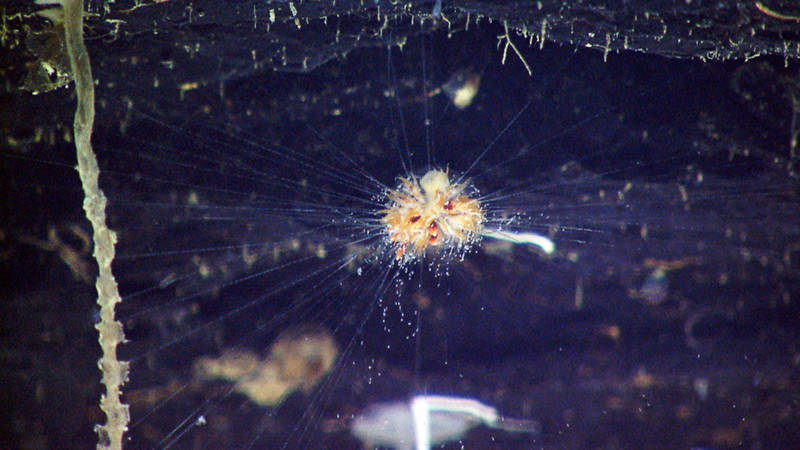
A dandelion, or rare benthic siphonophore, resides under a ledge along the West Florida Escarpment. Image courtesy of NOAA Okeanos Explorer Program, Gulf of Mexico 2014 Expedition. Download larger version (jpg, 2.1 MB).

A dandelion, or rare benthic siphonophore, resides under a ledge along the West Florida Escarpment. Image courtesy of NOAA Okeanos Explorer Program, Gulf of Mexico 2014 Expedition. Download larger version (jpg, 2.1 MB).
Okeanos Explorer EX1402L3
Many Mounds Deep, West Florida Escarpment. Video courtesy of NOAA Office of Ocean Exploration and Research. Download (mp4, 30.6 MB)
Dive 14 was the second dive along the central part of the West Florida Escarpment. Remotely operated vehicle Deep Discoverer (D2) arrived on the seafloor at 2,096 meters on a massive carbonate outcrop covered with soft sediment. The vehicles transited to the inner edge of the bench at 2,082 meters, then began up a steep slope with vertical intervals. This slope was composed of a series of steps formed by massive carbonate layers broken by small benches formed by bedding planes.Debris and soft sediment often accumulated on these benches. The top of the slope occurred at 1,887 meters and the ensuing broad bench was formed for the most part by a series of flat-lying stacked bedding planes. Some were the tops of massive layers, characterized by fossil burrows, algal mats, and drainage channels. At least 23 species of coral were observed, including many recruits, suggesting a healthy ecosystem that is ideal for recruitment. There was also an increase in coral abundance at ~1,970 meters. Rare sightings during this dive included a dandelion (benthic siphonophore), white fan bryozoans, a five-armed crinoid never before seen at this depth in the Gulf of Mexico, and four carnivorous sponges. Other species observed included glass and demosponges, a skate, two species of eels, crinoids, and bat stars. Just before the vehicles left the seafloor, some mollusk casts were seen in a large piece of debris, at 1,827 meters.